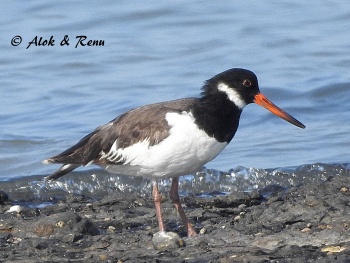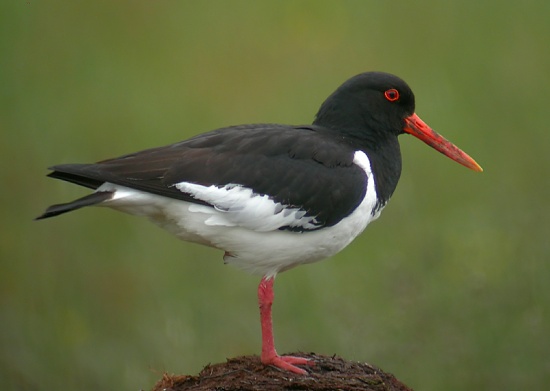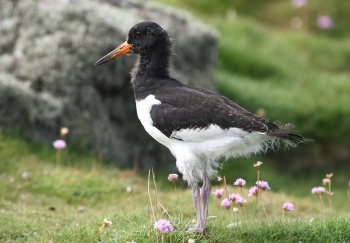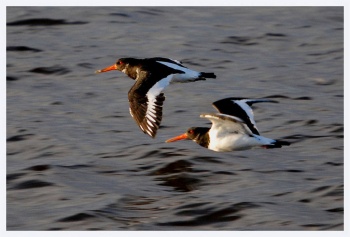- Haematopus ostralegus
Identification
40–47·5 cm (15¾-18¾ in)
- Black above
- White below
- White wing and tail patches
- Red legs
- Strong broad red bill
- Winter - white band across the throat interrupting the otherwise black neck
- Juvenile - brown with white neck band and dull bill. Bill is still growing after they reach the ability to fly.
Distribution
Widespread throughout Eurasia and Africa.
Rare migrant on Greenland. Accidental vagrant to Newfoundland (several records).
Taxonomy
Subspecies
There are 3 subspecies[1]:
- H. o. ostralegus - Iceland and Scandinavia to south Europe; winters to Africa
- H. o. longipes - Russia to Siberia and south to Caspian Sea and Aral Sea; winters to India
- H. o. osculans - Kamchatka Peninsula and North Korea; winters east China
Habitat
Beaches and coast in winter. Breeds in upload grassy areas.
Behaviour
Diet
The diet includes molluscs, mussels and earthworms.
Breeding
They nest in a scrape on pebbles which may be on the coast, riverside or in grassy fields and even upland moors. The clutch consists of 2-4 eggs which are coloured buff to yellow possibly with a greenish tint; there are variable markings of streaks and spots from greyish to black. There is a single clutch, usually in May.

Photo © by Alok Tewari
Jamnagar, Coastal Gujarat, India, 20 January 2016
Vocalisation
Eurasian Oystercatcher voice clip
References
- Clements, J. F., T. S. Schulenberg, M. J. Iliff, D. Roberson, T. A. Fredericks, B. L. Sullivan, and C. L. Wood. 2018. The eBird/Clements checklist of birds of the world: v2018. Downloaded from http://www.birds.cornell.edu/clementschecklist/download/
- Wikipedia contributors. (2018, July 26). Eurasian oystercatcher. In Wikipedia, The Free Encyclopedia. Retrieved 08:11, October 9, 2018, from https://en.wikipedia.org/w/index.php?title=Eurasian_oystercatcher&oldid=852049524 Wikipedia
- Chandler, R. (2009). Shorebirds of North America, Europe, and Asia: A photographic guide. Princeton.
- Hockey, P., Kirwan, G.M. & Boesman, P. (2018). Eurasian Oystercatcher (Haematopus ostralegus). In: del Hoyo, J., Elliott, A., Sargatal, J., Christie, D.A. & de Juana, E. (eds.). Handbook of the Birds of the World Alive. Lynx Edicions, Barcelona. (retrieved from https://www.hbw.com/node/53753 on 9 October 2018).
- Evans, G. & Swain, H.D. (1985). Observers Book of Birds Eggs. Frederick Warne.
Recommended Citation
- BirdForum Opus contributors. (2025) Eurasian Oystercatcher. In: BirdForum, the forum for wild birds and birding. Retrieved 14 May 2025 from https://www.birdforum.net/opus/Eurasian_Oystercatcher
External Links
GSearch checked for 2020 platform.1






